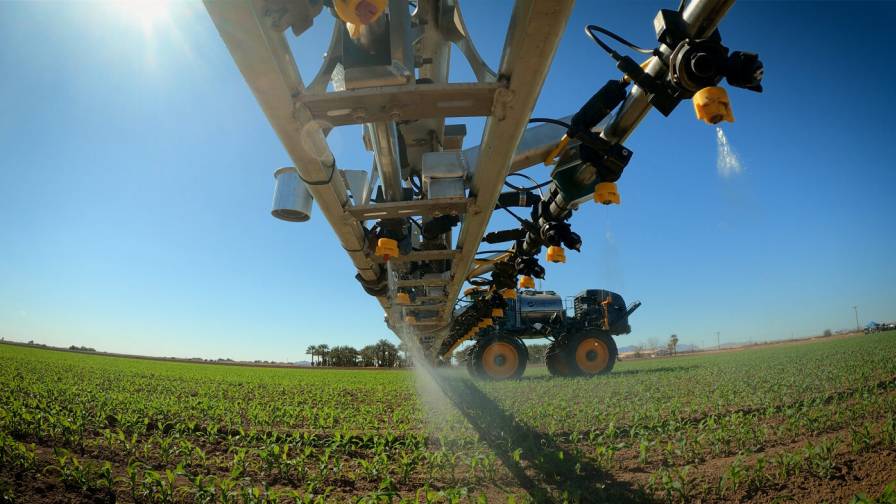Managing Weed Resistance Under Changing Environmental Conditions
Farmers encounter a host of obstacles each growing season, with 2023 lowlighted by drought conditions in the Midwest and excess moisture in the Northeast. While growers cannot predict the weather, they have some say on limiting the spread of weeds.
Today’s farmers are utilizing herbicides formulated to eliminate weeds even under changing environmental conditions. Syngenta has introduced its new corn herbicide Storen for the 2024 growing season. The pre- and post-emergence grass and broadleaf solution offers up to three weeks more residual weed control compared to competing herbicides, notes Product Lead Shawn Hock.
“We had excessive weather challenges this year, but we’ve been working with our distributors and channel partners, and have a robust supply chain,” says Hock. “It’s a long-term strategy that’s enabled us to be nimble in any market.”
Storen received federal approval in July, officially adding the product to Syngenta brands containing bicyclopyrone (BIR) as an active ingredient. The company’s new herbicide boasts four residual active components — BIR, mesotrione, S-metolachlor and pyroxasulfone — along with the benoxacor crop safener.
In combination, these chemicals provide robust control of barnyard grass, foxtail, water hemp, Palmer amaranth, giant ragweed, common ragweed, Russian thistle, cocklebur, and morning glory.
“Other herbicides have one active ingredient driving residual activity, so you’re not getting that consistent length of control,” Hock says. “You may get a short lasting residual, or control for one type of environment. But growers encounter different environments over the same growing season.”
The U.S. agriculture industry — particularly in soybean — is far removed from the “Roundup-ready era,” says Corteva Crop Protection Launch Leader Eric Scherder. In the last decade or two, crop weeds have become mostly resistant to popular glyphosate-based weed killers like Roundup.
“These products don’t use foundational chemicals, and aren’t diversifying their modes of action (MoA),” says Scherder. “Today, we’re seeing an overwhelming amount of acres receiving a pre-emergence product and two or three modes of action.”
Corteva seeks to meet contemporary needs with advancements in its weed-control portfolio. Upcoming commercial launch of its Vorceed Enlist corn product touts a corn rootworm stopper with the added benefit of curtailing late-season emerged broadleaf weed pressures.
The company is also updating products for improved weed management flexibility in light of ongoing U.S. drought conditions, Scherder says.
“When there’s no moisture, it’s hard for herbicides to get taken in by plants,” he says. “We’ve gotten more aggressive about our chemistries, plus more modes of action and additives that penetrate the leaf cuticle to get the product into weeds.”
Mitigating the Spread
Enlist’s corn trait overcomes weed tolerance to 2,4-D choline, glyphosate, glufosinate, and FOP herbicides. When applied according to label instructions, Enlist solutions feature near-zero volatility as well as reduced potential for physical drift. A wide application window further enables the use of Enlist in the mitigation of late-season broadleaf weeds.
Corteva conducted 30 field demonstrations for Enlist in diverse geographic and environmental conditions. Testing on corn and soybean cemented the necessity of a multiple-MoA product over solutions containing a single mode of action.
“For astute growers, an ounce of prevention is worth a pound of cure,” says Corteva’s Scherder. “Keeping resistance at bay is far better than skimping on MoA, then developing resistance later on.”
Hearty weeds are a constant sore spot for farmers, say ag experts. Per data from the USDA’s Economic Research Service, herbicide-impervious weeds cost U.S. and Canadian growers an estimated $43 billion in lost revenue each year.
AMVAC’s answer to this problem is its Impact family of herbicides, including the Impact Core brand introduced in 2021, says Midwest Marketing Manager Mark Foster. The topramezone-based post-emerge grass and broadleaf herbicide, which is based on the standard Impact Herbicide formulation, moderates the spread of resistant weeds and grasses such as water hemp, Palmer amaranth and giant ragweed.
Long-lasting product stability delivers reliable control even in wet conditions, says Foster. Impact Core is also viable as an early post-emergence application across a range of weed densities.
“The Impact family is a Group 27 herbicide product, which is in the HPPD (Hydroxyphenylpyruvate dioxygenase) family,” Foster says. “We’re helping growers overcome the resistance issues they’ve been seeing. Grass and broadleaf weed control gives farmers an alternative to using broad-spectrum glyphosate or dicamba.”
No (Weed) Escape
Corn and soybean are the main beneficiaries of Impact, adding to products like Python that, by itself, gives growers foundational control of more than 30 broadleaf weeds. However, AMVAC herbicides are not a standalone to ridding a field of weeds — instead, they should act as one component of a larger management program, Foster says.
“If growers knows they have tea weed in their soybean crop, they can use Python alongside a current herbicide program so they don’t have weed escapes,” he says. “The simple days of using one product are not here to stay.”

Greeneye Technology offers a precision spraying solution to ensure farmers get the most from their herbicides. Photo credit: Greeneye
Agritech company Greeneye Technology offers a precision spraying solution to ensure farmers get the most from their herbicides. Backed by Syngenta, the Israel-based firm has developed a proprietary innovation that cuts herbicide use by 78% while reducing chemical costs by more than half.
Using artificial intelligence, the Greeneye technology can detect and spray weeds with over 95% accuracy, according to the company. CEO and Co-founder Nadav Bocher says the system integrates into any brand or size of commercial sprayer, removing the need for users to invest in new machines.
“When designing the Greeneye system, we quickly realized that providing farmers with a tool to significantly reduce herbicide use was not enough on its own; they also needed to have complete confidence that it would deliver the same, or better, efficacy as broadcast application,” Bocher said in an email. “With the cost savings achievable with our system, farmers can invest in more complex tank mixes that were not affordable when applied on a broadcast basis, enabling them to manage weeds much more effectively, while also tackling resistance.”
Although the Greeneye system is currently engineered for use with soybean and corn, the innovation is customizable for any row crop, adds Bocher. A dataset of 200 broadleaf weeds and grasses is expanding the technology’s reach into new states, further eliminating one of the greatest threats to global crop production.
“Today, farmers address this challenge by spraying herbicides across the entire field — even though weed infestation may be as low as 10%,” says Bocher. “As a result, not only are farmers spending far more money on herbicides than they need to, but millions of gallons of herbicides are being needlessly sprayed each year, which is contributing to the mounting challenges posed by herbicide-resistant weeds, chemical drift, and soil and water contamination. Greeneye’s solution overcomes these challenges, offering farmers what we believe is the most advanced commercially-viable precision spraying technology on the market.”
A Crucial Measure of Success
Growers are enjoying positive outcomes from weed control programs that integrate best practice herbicide use, says Syngenta’s Hock. Syngenta’s Storen is useful against 70-plus weeds, a list encompassing Russian thistle, foxtail, and barnyard grass.
Wise farmers overlap herbicide applications alongside a comprehensive tillage and burndown program — this level of preparation provides effective weed control and decreases the seed bank of invading plants, Hock says.
“That’s key, because we want to control these weeds before they emerge,” says Hock. “Get that crop growing with a good canopy, and that’s where Storen comes in. We have replicated trials with a four to five bushel-per-acre advantage over our competitors. Our message is better yield is the better deal, so we’re pushing parts of our portfolio toward those outcomes.”
In the meantime, Enlist E3 from Corteva has claimed a sizable chunk of the soybean market, says launch leader Scherder. The company is also in the field providing education about the science behind Corteva’s chemistries as well as best-in-industry nozzle selection and spray patterns.
Corteva and other herbicide manufacturers are attentive to environmental impacts of their products as well. Enlist includes EPA-initiated protective measures to reduce volatility and protect crop-adjacent plant and animal species. Imparting this knowledge to growers can only strengthen their weed mitigation skills, Scherder says.
“With Enlist weed control, you’ll see cleaner fields, which is great for farmers,” says Scherder. “Half the ground in the U.S. is rented, so growers want that ground to be clean to rent the following year. Plus, storage of crops is easier because there’s no foreign matter in the grain.”
In 2022, AMVAC unveiled an online learning management system for ongoing education and training. Aimed at retailers, farmers, and advisors, the AMVAC Academy features self-guided learning modules across a range of topics including herbicide use. Additionally, the company markets its products through social media, while deploying a sales team for its burgeoning herbicide selection.
Customer service is a vital part of any ag company’s core business, especially considering the evolving needs of the nation’s farming community, says AMVAC’s Foster.
“Our measure of success is in grower confidence and repurchasing of products,” says Foster. “This is a highly competitive industry, and repeat purchases are critical. We’re always looking at creating new combinations of products that offer value to the farmer, whether in efficacy, ease of use, or expanded timing of product utilization.”





